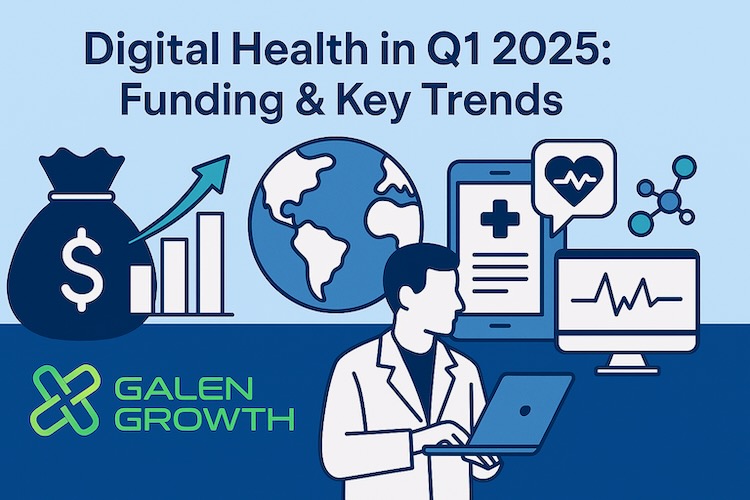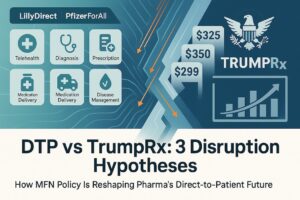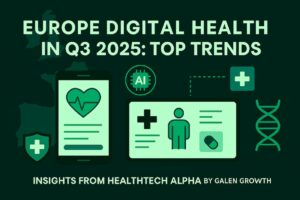Welcome to our FAQ summarising the key findings and trends regarding Digital Health funding and market movements in the first quarter of 2025, based on the provided excerpts. This information is crucial for understanding the current landscape of healthcare investment.
1. What was the overall funding picture for Global Digital Health in Q1 2025?
The global Digital Health sector experienced a resurgence in the first quarter of 2025, showing renewed vigour. Total funding for the quarter reached a robust $6.3 billion, representing a modest increase of 2% year-on-year (YoY). This strong start suggests the sector is resilient and progressing towards a new maturity phase. Overall, healthcare investment continues its growth trend.
2. How did the Average Digital Health Deal Size fare in Q1 2025?
Notably, the average deal size in Q1 2025 experienced a substantial uplift. It reached $27.0 million, marking a considerable increase of 85% year-on-year.
3. What role did ‘Mega Deals’ play in Q1 2025 Digital Health Funding?
Mega deals exceeding $100 million were particularly prominent and effectively dominated the funding landscape in Q1 2025. There were 15 such deals in the quarter. These mega deals accounted for 51% of global Digital Health funding.
The dominance of mega deals underscores that investors are doubling down on more mature platforms that have already demonstrated clinical impact, scalability, and monetisation potential. This signals that Digital Health is now viewed not just as an experiment, but as an integral and fundamental pillar of modern healthcare systems.
4. How did Digital Health Funding Trends vary across Global Regions in Q1 2025?
Funding distribution showed varied performance across key regions in Q1 2025:
- North America (US+) attracted the largest absolute funding, securing $3.6 billion. However, this represented a 20% decrease year over year.
- Europe experienced a significant surge, emerging as a ‘surprise contender’. Funding in Europe reached $2.0 billion (excluding exits), an impressive increase of 82% year-on-year. This growth was primarily fuelled by a handful of growth-stage mega deals, indicating that maturing ventures in the region are successfully attracting substantial private capital. Notably, this growth was driven by the private sector, suggesting strong investor confidence in Europe’s Digital Health ecosystem. This momentum is encouraging given broader macroeconomic challenges like inflationary pressures and monetary tightening. This marked Europe’s strongest Q1 in years.
- Asia Pacific saw $518 million in funding, with a modest increase of 9% year-on-year.
- The Middle East demonstrated remarkable growth, albeit from a smaller base, with $161 million invested, an impressive increase of 475% year-on-year.
5. Which Digital Health Clusters received the most funding in Q1 2025?
The top-funded clusters in Q1 2025 focus on areas leveraging Artificial Intelligence.
The leading clusters were:
- Medical Diagnostics, attracting $1.4 billion.
- Health Management Solutions (HMS), also securing $1.4 billion.
- Research Solutions (TechBio), with $1.2 billion in funding.
These top clusters share a common thread: the pervasive influence of Artificial Intelligence (AI).
6. What Therapeutic Areas saw the most investment in Q1 2025?
Based on the data provided, the top therapeutic areas by funding amount were:
- Neurology, receiving $900 million.
- Oncology, with $885 million.
- Cardiovascular Diseases, attracting $858 million.
7. What was the Digital Health M&A activity level in Q1 2025?
Mergers and Acquisitions (M&A) activity was robust in Q1 2025. A total of 51 M&A deals were recorded, representing a 21% increase year-on-year. A significant majority, 80% of these acquisitions, involved ventures founded in the United States.
8. What were the trends observed in Industry Partnerships in Q1 2025?
Partnership activity saw a decrease compared to the previous year. There were a total of 640 partnerships recorded, which is a decrease of 34% year-on-year. The most active industry verticals involved in these partnerships were:
- Healthcare providers (20%)
- Tech companies (17%)
- Pharmaceutical firms (9%)
- Medical Device companies (5%)
- Insurance providers (4%)
Several organisations were highlighted, including Teladoc Health, Zing Health, Vizient, NVIDIA, and AWS.
9. What was the impact of Artificial Intelligence (AI) on Digital Health funding in Q1 2025?
Artificial Intelligence is powering the investment engine in Digital Health, particularly evident in the United States. It is cited as the common denominator across the top-funded clusters: Medical Diagnostics, Health Management Solutions (HMS), and TechBio (Research Solutions). AI’s transformative capabilities in areas such as improving diagnostic accuracy, streamlining health workflows, and accelerating drug discovery continue to attract significant funding. These AI-led clusters accounted for a large share of Q1’s global deals. Investors are demonstrating a strong belief in platforms that not only digitise healthcare but fundamentally redefine it through intelligent, adaptive technologies. AI is seen as the ‘real engine of growth’ for Digital Health.
10. Why is Europe highlighted as a Surprise Contender in Q1 2025?
Europe’s performance in Q1 2025 was notably strong and somewhat surprising. The region posted an impressive 82% year-on-year increase in funding, reaching $2.0 billion. This marked Europe’s strongest first quarter in years. The surge was primarily driven by a few large growth-stage mega deals, showing that maturing European ventures successfully attract substantial private investment. The fact that this growth came from the private sector, rather than relying on public funding, is an encouraging sign of genuine investor confidence in the continent’s Digital Health ecosystem. This positive momentum is particularly noteworthy given the challenging broader economic climate.
11. What does the Q1 2025 Funding Picture suggest about the Digital Health Market’s Maturity?
The Q1 2025 funding trends strongly indicate that the Digital Health market is reaching a new maturity phase. The dominance of mega deals, where significant capital is invested in a smaller number of larger, more established companies, indicates investors favouring mature platforms that have already proven their clinical impact, scalability, and ability to generate revenue. This strategic shift away from scattering investments across many early-stage projects suggests a growing confidence in the sector’s ability to deliver tangible results and become an integral, rather than experimental, component of modern healthcare. Digital health is viewed as offering a rare combination of both stability and scale, which is appealing to investors.
12. How resilient is the Digital Health Sector to external economic factors like potential tariffs?
The Digital Health sector has demonstrated resilience to external economic factors, buoyed by strong underlying healthcare demand, ongoing digital transformation, and a surge in regional investment, particularly in Europe. However, rising tariff pressures, potential semiconductor duties, and currency fluctuations might further test this resilience. These factors could increase the cost of hardware components, disrupt global supply chains, and squeeze margins, especially for startups and scaleups reliant on imported technologies. Moreover, as corporates face higher operating costs and investor sentiment turns defensive, the sector’s access to capital and partnerships could tighten. While M&A activity and regional funding diversification provide some buffers, the sector’s resilience might ultimately depend on its ability to adapt supply chains, consolidate strategically, and navigate shifting investor priorities.
13. What were some of the most Notable Deals completed in Q1 2025?
Several significant deals contributed to the quarter’s funding total:
- Isomorphic Labs received a $600 million Strategic investment.
- Innovaccer completed a $275 million Series F round.
- Truveta raised $320 million in Series C funding.
- Neko Health secured $260 million in Series B funding.
- Amboss closed a $259 million Series C round.
These large deals contributed to the overall dominance of mega deals in the quarter.








